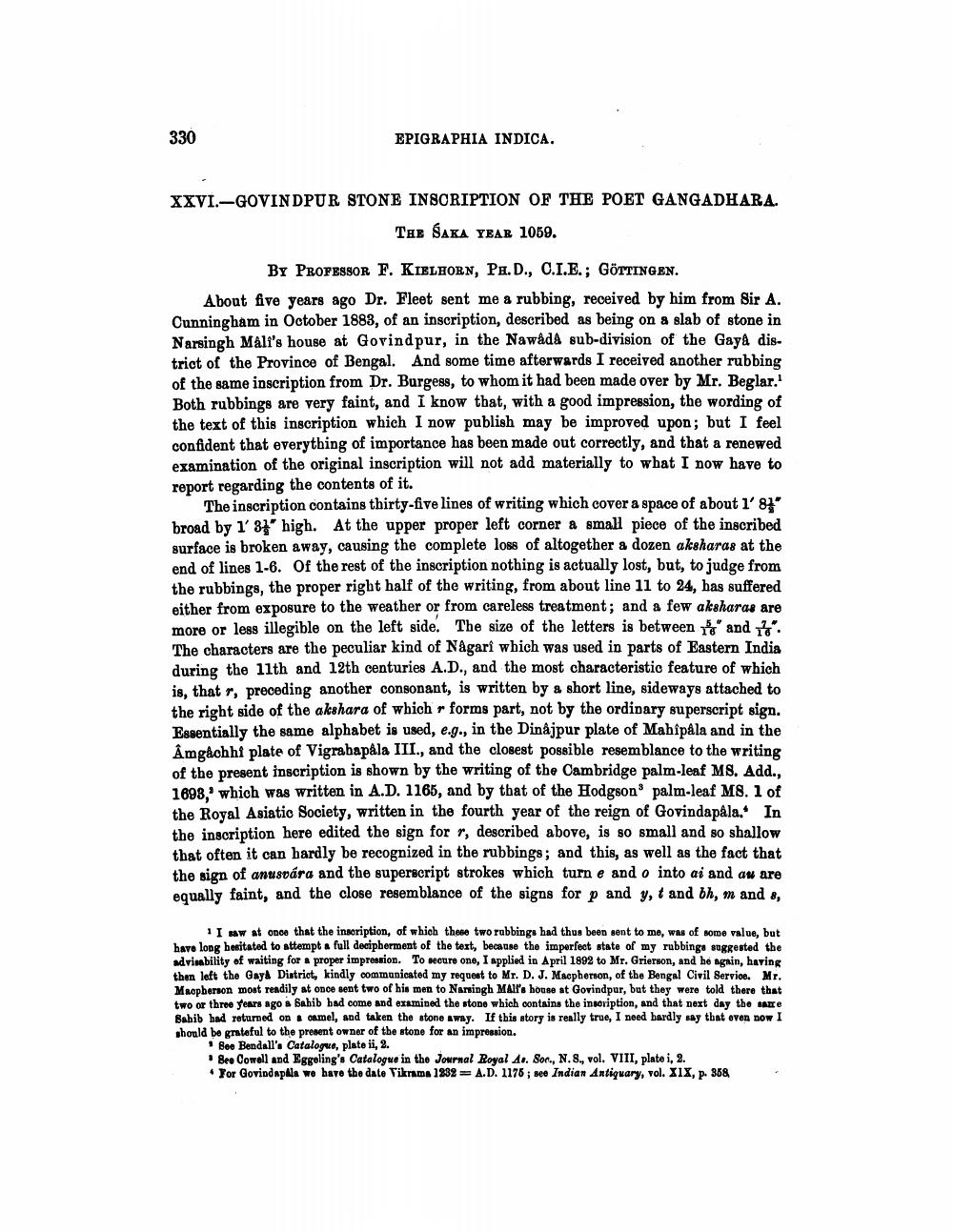________________
330
EPIGRAPHIA INDICA.
XXVI.-GOVINDPUR STONE INSCRIPTION OF THE POET GANGADHARA.
TAE SAKA YEAR 1059.
BY PROFESSOR F. KIELHORN, PE.D., C.I.E.; GÖTTINGEN. About five years ago Dr. Fleet sent me a rubbing, received by him from Sir A. Cunningham in October 1883, of an inscription, described as being on a slab of stone in Narsingh MAli's house at Govindpur, in the Nawada sub-division of the Gayà district of the Province of Bengal. And some time afterwards I received another rubbing of the same inscription from Dr. Burgess, to whom it had been made over by Mr. Beglar. Both rubbings are very faint, and I know that, with a good impression, the wording of the text of this inscription which I now publish may be improved upon; but I feel confident that everything of importance has been made out correctly, and that a renewed examination of the original inscription will not add materially to what I now have to report regarding the contents of it.
The inscription contains thirty-five lines of writing which cover a space of about 1' 87" broad by 1' 87' high. At the upper proper left corner a small piece of the inscribed surface is broken away, causing the complete loss of altogether a dozen aksharas at the end of lines 1-6. Of the rest of the inscription nothing is actually lost, but, to judge from the rubbings, the proper right half of the writing, from about line 11 to 24, has suffered either from exposure to the weather or from careless treatment; and a few aksharas are more or less illegible on the left side. The size of the letters is between " and ". The characters are the peculiar kind of Nagari which was used in parts of Eastern India during the 11th and 12th centuries A.D., and the most characteristic feature of which is, that r. preceding another consonant, is written by a short line, sideways attached to the right side of the akshara of which r forms part, not by the ordinary superscript sign. Essentially the same alphabet is used, e.g., in the Dinajpur plate of Mahipala and in the Åmgachhi plate of Vigrahapala III., and the closest possible resemblance to the writing of the present inscription is shown by the writing of the Cambridge palm-leaf MS. Add., 1898.) which was written in A.D. 1165, and by that of the Hodgson' palm-leaf MS. 1 of the Royal Asiatic Society, written in the fourth year of the reign of Govindapala. In the inscription here edited the sign for r, described above, is so small and so shallow that often it can hardly be recognized in the rubbings, and this, as well as the fact that the sign of anusvára and the superscript strokes which turn e and o into ai and an are equally faint, and the close resemblance of the signs for p and y, t and bh, m and s.
1 I saw at once that the inscription, of which these two rabbings had thus been sent to me, was of some value, but have long hesitated to attempt a full decipherment of the test, because the imperfect state of my rubbinga suggested the advisability of waiting for a proper impression. To secure one, I applied in April 1892 to Mr. Grierson, and he again, having then left the Gaya District, kindly communicated my request to Mr. D. J. Macpherson, of the Bengal Civil Service. Mr. Macpherson most readily at once sent two of his men to Narsingh MAli's house at Govindpur, but they were told there that two or three years ago a Bahib had come and examined the stone which contains the insoription, and that next day the same Babib had returned on camel, and taken the stone away. If this story is really true, I need hardly say that even now I should be grateful to the present owner of the stone for an impression.
Bee Bendall's Catalogus, plate ii, 2. • Bee Cowell and Eggoling's Catalogue in the Journal Royal 40. Son., N. 8., vol. VIII, plate i, 2.
For Govindapála we have the date Tikrama 1232 = A.D. 1176 ; see Indian Antiquary, vol. XIX, p. 368




